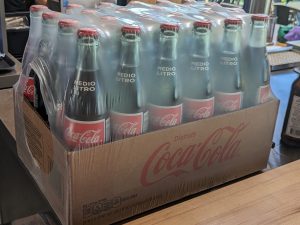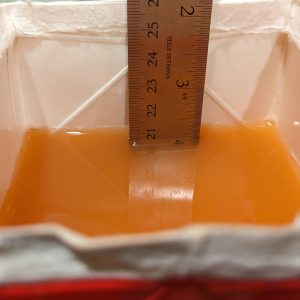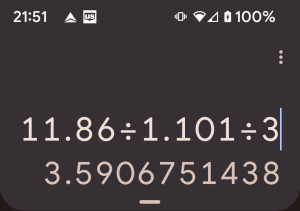Exercise Answers
Module 1: Order of Operations
























 °F
°F °C
°C
Module 2: Negative Numbers








 °F
°F


























- undefined






Module 3: Decimals
If you’ve seen Modules 5 & 6, don’t worry about accuracy or precision on these exercises.






















 per month
per month miles per hour
miles per hour
Module 4: Fractions







- undefined






- at least
 questions
questions 

 scoops
scoops- A requires
 cup more than B
cup more than B  of the pizza
of the pizza more
more inches combined
inches combined inches difference
inches difference combined
combined more
more

 or
or 
 or
or 







 cup
cup
Module 5: Accuracy and Significant Figures
- exact value
- approximation
- exact value
- approximation
- exact value
- approximation
- three significant figures
- four significant figures
- five significant figures
- two significant figures
- three significant figures
- four significant figures
- two significant figures; the actual value could be anywhere between
 and
and 
- three significant figures; the actual value could be anywhere between
 and
and 
- four significant figures; the actual value could be anywhere between
 and
and 
- five significant figures; the actual value could be anywhere between
 and
and 


















Module 6: Precision and GPE
- thousands
- hundreds
- tens
- thousandths
- ten thousandths
- hundred thousandths






 lb
lb lb
lb

- thousands place; the nearest
 people
people  people
people- hundred thousandths place; the nearest
 in
in  in
in- hundredths place; the nearest
 mil
mil  mil
mil miles
miles- ones place; the nearest
 mile
mile  mi
mi- ones place; the nearest
 minute
minute  min
min- two sig figs
- three sig figs
 mi/hr
mi/hr- When dividing, we must round the result based on the accuracy; i.e., the number of significant figures.
Module 7: Formulas
 (oops—the print edition says
(oops—the print edition says  )
)



 representatives
representatives representatives
representatives representatives
representatives electoral votes
electoral votes electoral votes
electoral votes electoral votes
electoral votes °F; the official record high in the city was 116°F.
°F; the official record high in the city was 116°F. °C
°C °F
°F °C
°C mm Hg
mm Hg- around
 mm Hg
mm Hg  in
in in
in- yes
- no; too large
- no; too small
- yes
Module 8: Perimeter and Circumference
 ft
ft cm
cm cm
cm ft
ft ft
ft ft
ft in
in cm (the print textbook says
cm (the print textbook says  cm, which implies only one sig fig…)
cm, which implies only one sig fig…) in
in cm
cm ft
ft m
m
Module 9: Percents Part 1
Module 10: Ratios, Rates, Proportions


 or
or  miles per hour
miles per hour /oz, or
/oz, or  ¢/oz
¢/oz

Carmella Creeper parties like it’s 1995.  /oz, or
/oz, or  ¢/oz
¢/oz /oz, or
/oz, or  ¢/oz
¢/oz ; true
; true ; false
; false ; true
; true ; false
; false ; false
; false ; true
; true





 miles
miles hours
hours miles (rounding to one sig fig seems like a good idea here)
miles (rounding to one sig fig seems like a good idea here) pixels wide
pixels wide
Module 11: Scientific Notation
- Earth’s mass is larger because it’s a
 -digit number and Mars’ mass is a
-digit number and Mars’ mass is a  -digit number, but it might take a lot of work counting the zeros to be sure.
-digit number, but it might take a lot of work counting the zeros to be sure. - Earth’s mass is about ten times larger, because the power of
 is
is  higher than that of Mars.
higher than that of Mars. - A chlorine atom’s radius is larger because it has
 zeros before the significant digits begin, but a hydrogen atom’s radius has
zeros before the significant digits begin, but a hydrogen atom’s radius has  zeros before the significant digits begin. As above, counting the zeros is a pain in the neck.
zeros before the significant digits begin. As above, counting the zeros is a pain in the neck. - The chlorine atom has a larger radius because its power of
 is
is  higher than that of the hydrogen atom. (Remember that
higher than that of the hydrogen atom. (Remember that  is larger than
is larger than  because
because  is farther to the right on a number line.)
is farther to the right on a number line.)  ;
; 
 ;
; 












 people per square mile
people per square mile people per square mile
people per square mile- the proton’s mass is roughly
 or
or  times larger
times larger  ;
; 
 ;
; 
 ;
; 
 per person
per person
Module 12: Percents Part 2 and Error Analysis
 or
or 



 or
or 



 or
or 
 grams of added sugars is the recommended daily intake for a
grams of added sugars is the recommended daily intake for a  calorie diet.
calorie diet. increase
increase sales tax
sales tax decrease
decrease decrease
decrease

 g;
g;  g
g
 g;
g;  g
g
Module 13: The US Measurement System
We generally won’t worry about significant figures in these answers; we’ll probably say “![]() miles” even if “
miles” even if “![]() miles” is technically correct.
miles” is technically correct.
 in
in ft
ft in
in yd
yd ft or
ft or  ft
ft  in
in yd
yd mi
mi yd
yd oz
oz lb
lb- 18.75 lb
 oz
oz fl oz
fl oz pt
pt pt
pt c
c gal
gal fl oz
fl oz lb
lb  oz
oz c
c  fl oz
fl oz ft
ft  in
in t
t  lb
lb lb or
lb or  lb
lb  oz combined
oz combined lb
lb  oz heavier
oz heavier ft
ft  in combined
in combined ft
ft  in longer
in longer
Module 14: The Metric System
 m
m cm
cm km
km m
m cm
cm mm
mm cm
cm mm
mm m
m cm
cm m
m cm
cm km
km dam
dam g
g kg
kg mg
mg kg
kg g
g mg
mg cg
cg mg
mg kg
kg cg
cg g
g L
L mL
mL L
L dL
dL mL
mL L
L- they are equal in size
- about
 to
to 
 bottles; this is easier if you know that a 500-milliliter bottle of Mexican Coke is called a medio litro.
bottles; this is easier if you know that a 500-milliliter bottle of Mexican Coke is called a medio litro.

Doce litros de Coca-Cola
Module 15: Converting Between Systems
We may round some of these answers to three significant figures even if the given number has fewer than three sig figs. On the other hand, you’ll see that some of these answers include a critique of a manufacturer’s decision to round numbers a certain way.



- yes,
 according to the conversion, but is it really
according to the conversion, but is it really  to begin with? Rounding the result to
to begin with? Rounding the result to  or
or  seems reasonable.
seems reasonable.  in converts to around
in converts to around  cm, and
cm, and  cm converts to around
cm converts to around  in. It looks like somebody used the conversion
in. It looks like somebody used the conversion  , which is fine if you’re estimating but not if you’re going to report a number to three sig figs.
, which is fine if you’re estimating but not if you’re going to report a number to three sig figs.- not exactly but they’re pretty close; the error is around
 . (oops—the print edition says
. (oops—the print edition says  )
) - yes; using either conversion gives a result of
 kg, rounded to the nearest tenth. However, it doesn’t make sense for this to be accurate to four sig figs. It would be best to round to
kg, rounded to the nearest tenth. However, it doesn’t make sense for this to be accurate to four sig figs. It would be best to round to  or perhaps even
or perhaps even  kg.
kg. - not exactly; using 1 kg
 lb gives a result of
lb gives a result of  kg, and using 1 lb
kg, and using 1 lb  kg gives a result of
kg gives a result of  kg. Again, the accuracy here doesn’t make sense, especially when you consider that the numbers on the box don’t agree with each other:
kg. Again, the accuracy here doesn’t make sense, especially when you consider that the numbers on the box don’t agree with each other:  .
. 



- about

- about




- no matter which conversion you use, the result should round to
 liters.
liters. - a bit less than


Module 16: Other Conversions
We will generally round these answers to three significant figures; your answer may be slightly different depending on which conversion ratio you used.
 min; if you’re familiar with the musical Rent, then you already knew the answer.
min; if you’re familiar with the musical Rent, then you already knew the answer.- this is roughly
 years, which is indeed possible
years, which is indeed possible  km/hr
km/hr mi/hr
mi/hr mi/hr
mi/hr mi in
mi in  min
min min
min mi/gal
mi/gal gal/mi
gal/mi gal in
gal in  min
min- the capacity increased by a factor of

 times greater
times greater watts per home, or
watts per home, or  kilowatts per home (oops—the print edition says
kilowatts per home (oops—the print edition says  megawatts)
megawatts) watt per gallon
watt per gallon times more powerful
times more powerful ms,
ms,  ms,
ms,  ms;
ms;  μs,
μs,  μs,
μs,  μs
μs- the ratio of the wavelengths of red and infrared is
 to
to  ;
;
the ratio of the wavelengths of infrared and red is around to
to 
- this is equivalent to
 chest x-rays
chest x-rays
Module 17: Angles
- right angle
- obtuse angle
- reflexive angle
- straight angle
- acute angle
 ;
;  ;
; 


 each
each each
each each
each ;
;  ;
; 






Module 18: Triangles
- right isosceles triangle
- obtuse scalene triangle
- acute equilateral triangle (yes, an equilateral triangle will always be acute)

 ;
; 


- this is a right triangle, because
 .
. - this is not a right triangle, because
 .
. 






Module 19: Area of Polygons and Circles
We may occasionally include extra sig figs in these answers so you can be sure that your answer matches ours.
Module 20: Composite Figures


 ; the area of the rectangle is
; the area of the rectangle is  and the areas of the triangles are
and the areas of the triangles are  and
and  .
. ; hey, that’s what we got for #3!
; hey, that’s what we got for #3!

- Based on the stated measurements, the distance around the track will be 401 meters, which appears to be 1 meter too long. In real life, precision would be very important here, and you might ask for the measurements to be given to the nearest tenth of a meter.
- around




 (oops—the print edition says
(oops—the print edition says  )
)- around
 (Hint: Make up an easy number for the side of the square, like 2 or 10.)
(Hint: Make up an easy number for the side of the square, like 2 or 10.) - around
 (Hint: The diagonals of the square are equal to the circle’s diameter.)
(Hint: The diagonals of the square are equal to the circle’s diameter.)
Module 21: Converting Units of Area
We may occasionally include extra sig figs in these answers so that you can be sure that your answer matches ours.













 , rounded to two sig figs
, rounded to two sig figs
 , rounded to three sig figs
, rounded to three sig figs

 to
to  ; if we double the linear measurement, we get four times the area.
; if we double the linear measurement, we get four times the area.

 to
to  ; if we triple the linear measurement, we get nine times the area.
; if we triple the linear measurement, we get nine times the area.
Module 22: Surface Area of Common Solids
Module 23: Area of Regular Polygons
All answers have been given to two or three significant figures.






 (the area of the circle
(the area of the circle  and the area of the hexagon is
and the area of the hexagon is  )
)
Module 24: Volume of Common Solids








 or
or 
 (the cylinder’s volume
(the cylinder’s volume  and the hemisphere’s volume
and the hemisphere’s volume  .)
.) (the cylinder’s volume
(the cylinder’s volume  and the two hemispheres’ combined volume
and the two hemispheres’ combined volume  )
) , which is more than
, which is more than  .
.
Module 25: Converting Units of Volume
- the result is very close to
 cubic yard:
cubic yard: 
- this estimate is also
 cubic yard:
cubic yard: 
- around
 gallons
gallons - yes, the can is able to hold
 fluid ounces; the can’s volume is roughly
fluid ounces; the can’s volume is roughly  .
.  gallons
gallons- around
 to
to  liters; a calculator says
liters; a calculator says  liters which should technically be rounded up to
liters which should technically be rounded up to  liters, but it would be reasonable to round down to
liters, but it would be reasonable to round down to  liters instead if you considered the volume of the benches and the fact that the sides might slope inwards near the bottom of the tub.
liters instead if you considered the volume of the benches and the fact that the sides might slope inwards near the bottom of the tub. - the rectangular section of the carton has a volume of
 liters, which is larger than the required
liters, which is larger than the required  .
.  high
high

Independent verification from my kitchen. 





 ; assuming that it’s
; assuming that it’s  , these measures are equivalent to two sig figs.
, these measures are equivalent to two sig figs.
 ; now you can laugh whenever you see someone in a heist movie load a cheap duffel bag with gold bars and carry it out of the vault.
; now you can laugh whenever you see someone in a heist movie load a cheap duffel bag with gold bars and carry it out of the vault.


 to
to 


 to
to 
Module 26: Pyramids and Cones


 ;
; 

 (if we had greater accuracy, the result would be 314.16 because it’s 100 times
(if we had greater accuracy, the result would be 314.16 because it’s 100 times  .)
.)
 ;
; 
 ;
; 
Module 27: Percents Part 3

 students; notice that if the percent had fewer than five sig figs, we wouldn’t have been able to get an answer that was accurate to the nearest whole number.
students; notice that if the percent had fewer than five sig figs, we wouldn’t have been able to get an answer that was accurate to the nearest whole number.- Yes, you can! Each bottle cost
 .
.

Real time screenshot of my phone’s calculator.  million
million people
people ; the percent has only two sig figs, so it doesn’t make sense to assume that the price was
; the percent has only two sig figs, so it doesn’t make sense to assume that the price was  . They probably rounded the percent from
. They probably rounded the percent from  to make the numbers in the advertisement seems less complicated.
to make the numbers in the advertisement seems less complicated.
Module 28: Mean, Median, Mode


 (because it is the seventh value in the list of thirteen)
(because it is the seventh value in the list of thirteen)




- the median is more representative because the mean is higher than five of the six home values.
 (because it appears four times in the list)
(because it appears four times in the list)- no mode (there are no repeated values)
- AT&T Mobility
- Samoas and Thin Mints
 games
games games
games games
games- they all represent the data fairly well;
 wins represents a typical Patriots season.
wins represents a typical Patriots season.  games
games games
games games
games- they all represent the data fairly well;
 or
or  wins represents a typical Bills season.
wins represents a typical Bills season.  grams; the mean doesn’t seem to represent a typical clementine because there is a group of smaller ones (from
grams; the mean doesn’t seem to represent a typical clementine because there is a group of smaller ones (from  to
to  grams) and a group of larger ones (from
grams) and a group of larger ones (from  to
to  grams) with none in the middle.
grams) with none in the middle. grams; for the same reason, the median doesn’t represent a typical clementine, but you could say it helps split the clementines into a lighter group and a heavier group.
grams; for the same reason, the median doesn’t represent a typical clementine, but you could say it helps split the clementines into a lighter group and a heavier group.- no mode; too many values appear twice.
 grams; this is a small increase over the previous mean.
grams; this is a small increase over the previous mean. grams; the median does not change when one of the highest numbers increases.
grams; the median does not change when one of the highest numbers increases. grams; you might say it represents the mass of a typical large clementine, but it doesn’t represent the entire group.
grams; you might say it represents the mass of a typical large clementine, but it doesn’t represent the entire group.
Module 29: Probability



















- we should expect
 copies to be acceptable
copies to be acceptable 
- we should expect
 tax returns to have errors
tax returns to have errors 







Module 30: Standard Deviation
 ;
; 
 ;
; 
 ;
; 
 ;
; 
 ;
; 
 ;
; 
 because
because 
 lb because this is halfway between
lb because this is halfway between  and
and  lb
lb lb because
lb because  lb and
lb and  lb encompasses
lb encompasses  of the data
of the data ;
; 
 ;
; 
- You would not have predicted this from the data because it is more than two standard deviations below the mean, so there would be a roughly
 chance of this happening randomly. In fact,
chance of this happening randomly. In fact,  is slightly larger than
is slightly larger than  , so this is more than three standard deviations below the mean, making it even more unlikely. (You might have predicted that the Patriots would get worse when Tom Brady left them for Tampa Bay, but you wouldn’t have predicted only
, so this is more than three standard deviations below the mean, making it even more unlikely. (You might have predicted that the Patriots would get worse when Tom Brady left them for Tampa Bay, but you wouldn’t have predicted only  wins based on the previous nineteen years of data.)
wins based on the previous nineteen years of data.)  ;
; 
- You would not predict this from the data because it is more than two standard deviations above the mean, so there would be a roughly
 chance of this happening randomly. In fact,
chance of this happening randomly. In fact,  , so this is more than three standard deviations above the mean, making it even more unlikely. This increased win total is partly due to external forces (i.e., the Patriots becoming weaker and losing two games to the Bills) but even
, so this is more than three standard deviations above the mean, making it even more unlikely. This increased win total is partly due to external forces (i.e., the Patriots becoming weaker and losing two games to the Bills) but even  wins would have been a bold prediction, let alone
wins would have been a bold prediction, let alone  .
.  ;
; 
- The trouble with making predictions about the Broncos is that their standard deviation is so large. You could choose any number between
 and
and  wins and be within the
wins and be within the  interval.
interval.  , so this is around
, so this is around  standard deviations below the mean, which makes it not very unusual. Whereas the Patriots and Bills are more consistent, the Broncos’ win totals fluctuate quite a bit and are therefore more unpredictable.
standard deviations below the mean, which makes it not very unusual. Whereas the Patriots and Bills are more consistent, the Broncos’ win totals fluctuate quite a bit and are therefore more unpredictable.
Module 31: Right Triangle Trigonometry
- the adjacent side is e, the opposite side is f, and the hypotenuse is d.
- the adjacent side is x, the opposite side is y, and the hypotenuse is r.


















- the wire is approximately
 long
long  , which is roughly
, which is roughly 
- No;
 , so the puck will hit the fabric over 1 foot away from the center of the hole. (The person in the photo was given a bunch of pucks and 30 seconds to score, but he scored on his first shot. Boston Bruins at Vancouver Canucks, February 24, 2024.)
, so the puck will hit the fabric over 1 foot away from the center of the hole. (The person in the photo was given a bunch of pucks and 30 seconds to score, but he scored on his first shot. Boston Bruins at Vancouver Canucks, February 24, 2024.) 







 ;
; 
 angle of elevation
angle of elevation- Yes;
 , which is less than
, which is less than  .
. 



- All three answers are the same rounded to three significant figures. This is true because we rounded
 to the nearest tenth; if we had rounded it to
to the nearest tenth; if we had rounded it to  instead of
instead of  , we would have decreased the accuracy of #36 & #37 to only two sig figs and the three results all would have been slightly different.
, we would have decreased the accuracy of #36 & #37 to only two sig figs and the three results all would have been slightly different. 

Module 32: Slope
 ,
,  ,
, 
 ,
,  ,
, 
 ,
,  ,
, 
 ,
,  ,
, 







 from vertical. (this would be an angle of depression of
from vertical. (this would be an angle of depression of  .)
.) ; the proportion
; the proportion  gives a result of exactly
gives a result of exactly  .
.
Using the result from #7, the equation gives a result very close to
gives a result very close to  .
.
Module 33: Non-Right Triangle Trigonometry

 ;
; 
 ;
; 
- the shorter wire is roughly
 feet; the longer wire is roughly
feet; the longer wire is roughly  feet.
feet.

Exercise 4 is based on actual events! 




- the distance across the pond is roughly
 meters.
meters.  ;
;  ;
; 
Module 34: Radian Measure

